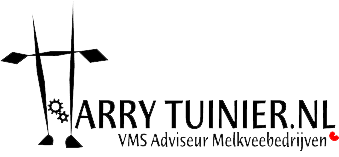Meadows: Sum: How big should the pasture plots be?
Or how long can cows last with a parcel or part?
If it grows nicely in the spring, it will grow at least 100 kg dm. Per hectare per day.
This decreases further in the growing season, about 80 kg per day and in autumn or during drought it can drop to less than 40 kg per day.
If you do “Standweiden” (on one parcel for a longer time), it is sufficient for grazing when there is 800 – 1000 kg dm. on a hectare. (Is about 10 cm.) Otherwise the last grass will quickly become too long and the cows too selective.
Suppose you have 100 cows and you want them to eat 6 kg per day of grass. That is 600 kg of dm. grass.
You want to let them graze for ten days on that plot. That means 10 x 600 = 6000 kg dm. in total.
You placed them in 1000 kg of dm. grass what was on it.
In those ten days, 80 kg dm. per day also grows = 800 kg
1000 kg present + 800 kg growth = 1800 kg present grass.
When the cows are removed, there may still be 1000 kg dm. per ha. So the growth, 80 kg per day for example, is to eat.
The requirement is 100 cows x 6 kg dm. grass intake x 10 days = 6,000 kg dm.
6,000 kg of grass required divided by 800 yield means that you need 7.5 ha of grassland for this. It is safe to take a little more.
Sum:
100 cows x 6 kg dm. X 10 days = 6000 kg dm.
10 days growth x 80 kg = 800 kg dm. 6000: 800 = 7.5 ha
Your situation:
…… cows x… kg dm. X…. days = ……… kg dm
…. days of growth x.…. kg = …… .. kg. dm. ………: ……… = …… ha
If you do “Roterend Standweiden”, so called “New Dutch Grazing”, or in other words a fresh part of pasture every day, you can start when the grass is slightly higher at, for example, 1500 kg ds. When it is “finished” there is still 600 kg ds. 900 kg has been eaten. An additional 80 kg of growing is added = 980 grass to eat.
100 cows x 6 kg DM intake = 600 kg DM per day required. 980 kg dry matter per ha crop yield divided by 600 is a bit more than 0.6 ha per day.
So then you need blocks of a bit more than 0.6 ha per day. For a round of “Rotating Stand Grazing” , for example, 15 days: 15 x 0.61 = 9.2 ha. Here too, if possible, take a little more when possible.
Sum:
100 cows x 6 kg DM x 1 day = 600 kg intake: 980 kg grass yield = 0.6 ha per day x number of days = a block of 9.2 ha.
Your situation:
…. cows x… kg DM x 1 day = ……. kg intake:… … kg grass yield =… .. ha per day x …… days = a block of …. ha.
Perhaps it is useful to make an excel for this (with a grazer coach?) And to enter the fixed formulas and numbers and how much additional feed you will have in the barn.
With your growth estimates, this will mean fewer surprises and a more constant supply of grass for the cows.
So grazing more successfully.
Remember that a cow eats about 1 kg per hour. Especially in the evening before sunset and in the morning after sunrise, the cows eat the most.
Robot milkers have no problems with that 😉
See previous Tips about pastures from May 2017 and August 2018.






